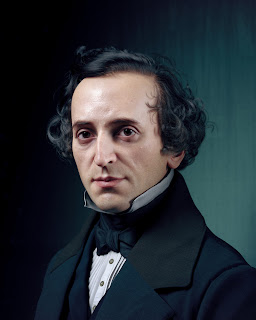Felix Mendelssohn
The symphony was written for a full orchestra and was Mendelssohn's second extended symphony. It was not published until 1868, 21 years after the composer's death – hence its numbering as '5'. Although the symphony is not very frequently performed, it is better known today than when it was originally published. Mendelssohn's sister, Fanny Mendelssohn Hensel, chose the name ReformationSymphony.
 By the time, Mendelssohn began writing his ReformationSymphony in 1829, he was still only 20 but had moved far beyond child-prodigy status. In fact, he had already launched a revival of Bach's music with his celebrated performances of the St. Matthew was one of the most renowned musicians in Germany as a pianist and conductor as well as composer. But this Symphony was to become one of the few major disappointments in a career marked more by triumphs than failures.
By the time, Mendelssohn began writing his ReformationSymphony in 1829, he was still only 20 but had moved far beyond child-prodigy status. In fact, he had already launched a revival of Bach's music with his celebrated performances of the St. Matthew was one of the most renowned musicians in Germany as a pianist and conductor as well as composer. But this Symphony was to become one of the few major disappointments in a career marked more by triumphs than failures.
With his growing celebrity, Mendelssohn had every expectation he would be called upon to compose music for the gala commemoration of the 300th anniversary of the Augsburg Confession — Martin Luther's declaration of the doctrines of the new Protestant faith — in Berlin on June 25, 1830. Though born into an illustrious Jewish family — his grandfather was the noted philosopher Moses Mendelssohn — Mendelssohn was baptized at seven and reared in the Lutheran Church. Thus, the Augsburg tercentenary stimulated the most ambitious orchestral work he'd yet tackled, grand and heroic in tone and scored for a large ensemble with full brass complement.
However by the time he completed the work in May 1830, Mendelssohn already knew his new symphony would not be played at the Berlin celebration. Many commentators have claimed the festivities were cancelled, but musicologist Judith Silber has recently produced contemporary newspaper evidence that they did in fact take place, with music by the now forgotten Eduard Groll. Why was Mendelssohn passed over for this occasion? No one knows for certain, but it seems that choral music to appropriate religious texts was used and that Mendelssohn's purely instrumental symphony may not have seemed suitable. And anti-Semitism may also have played a part.

Believing in his symphony, over the next two years Mendelssohn urgently but vainly sought a premiere in Munich, Leipzig, and Paris. Paris dealt him a wounding blow when, after one rehearsal of the work, he was told the Conservatoire musicians found the work “too learned, [with] too much fugato, [and] too little melody.” No performance took place, though a cholera epidemic in the city that closed all theaters may have sunk the symphony rather than the musicians' quibbles. Finally, a belated premiere took place in Berlin on November 15, 1832 to mixed reviews.
Gradually, Mendelssohn turned against his ill-starred symphony and declared it a failure. In 1838 he wrote: “I can hardly stand the Reformation Symphony anymore and would rather burn it than any other piece of mine; [it] shall never be published.” And indeed the work was not published until 1868, two decades after his death. Therefore, it received the misleading designation of “Symphony No. 5,” though it was actually the second of his mature symphonies, predating the “Scottish” and the “Italian.”
This stirring, richly contrapuntal work, however, has finally come into its own as one of Mendelssohn's most frequently performed scores. Its first movement rises from the low strings in a solemn layering of instrumental entrances that Silber calls “a brilliant orchestral evocation of Renaissance polyphony.” Last to enter are the violins, who softly sing the traditional Protestant “Dresden Amen,” which Wagner later exploited in his religious opera Parsifal (heard here last season). Wind fanfares accentuate the ceremonial mood. A bold and militant ascending theme introduces the Allegromain section; marked “con fuoco” — “with fire” — it seems a musical portrait of the pugnacious Luther and the fierce struggle between Catholics and Protestants in the 16th century. Fanfares drive the middle development section, which grows steadily in volume and turbulence. Then a surprise: the violins softly repeat the “Dresden Amen,” and Luther's fiery theme returns, now subdued and almost gentle.
 The two middle movements are lyrical interludes, contrasting with the heroic outer movements. First comes the scherzo: a robust German folk dance emphasizing crisp rhythms and including a wonderfully outdoorsy (with trilling woodwind birds) trio section in the middle. Movement three is a lovely “Song Without Words” for the first violins with discreet orchestral accompaniment.
The two middle movements are lyrical interludes, contrasting with the heroic outer movements. First comes the scherzo: a robust German folk dance emphasizing crisp rhythms and including a wonderfully outdoorsy (with trilling woodwind birds) trio section in the middle. Movement three is a lovely “Song Without Words” for the first violins with discreet orchestral accompaniment.
This leads without pause into the opening of the finale, with a solo flute chastely singing Luther's great hymn “Ein feste Burg” — “A Mighty Fortress is Our God.” Gradually, other instruments join in, swelling the majesty of the chorale. Phrases of the chorale in different instruments over a galloping rhythm lead to the Allegro maestoso of a movement Silber calls “a hybrid of sonata form and chorale variations.” Throughout, elaborate fugal passages recall another great Lutheran musician, J. S. Bach. A grandly stretched-out reprise of “A Mighty Fortress” by the full orchestra makes a splendidly triumphant conclusion.
Watch video here
Notes by Janet E. Bedell copyright 2018







